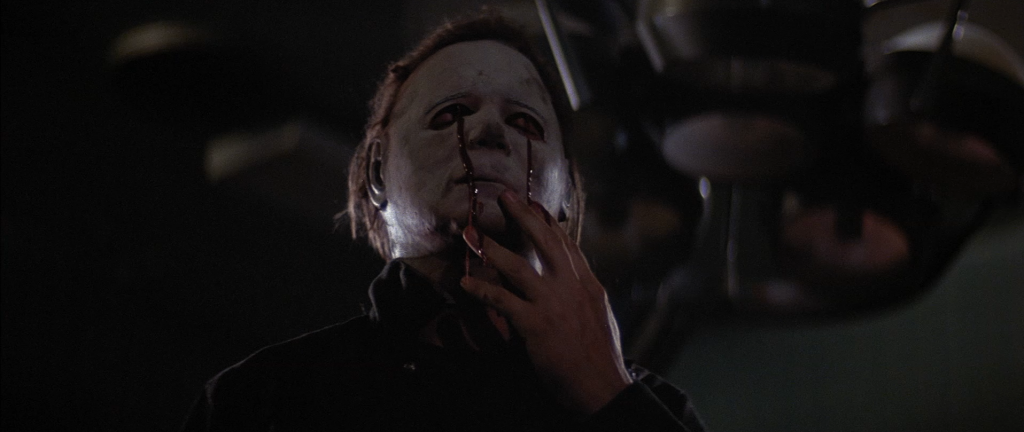
“We’re all afraid of the dark inside ourselves.”
Halloween II, 1981 (Jamie Lee Curtis) MCA/Universal
There were plenty of “slasher” movies being made between Psycho and Halloween. A quick trip to the Wikipedia will yield the first Coppola movie, Dementia 13 (about an axe murderer), the fruit of Hammer Studios with Maniac, Hysteria, and Crescendo. In Italy, something amazing was happening with the “Giallo” films, Dario Argento and Lamberto Bava. At the drive-in, Herschell Gordon Lewis released Blood Feast and Two-Thousand Maniacs! In more mainstream waters, Tobe Hooper and Wes Craven made names for themselves with The Texas Chainsaw Massacre and The Last House on the Left.
John Carpenter’s Halloween might’ve kicked off what is commonly referred to as the “golden age” of slasher movies, but it was, by no means, the first movie to break that ground. I think what separates Halloween from many of those films is the presentation. Halloween began as a routine “exploitation” film when Irwin Yablans and Moustapha Akkad asked John Carpenter and his producer-wife, Debra Hill to construct a simple “Ten Little Indians” story about a masked lunatic who murders a bunch of people on Halloween night. The Babysitter Murders was renamed Halloween, shot over four weeks on a $300,000 budget, and released a week shy of Halloween in 1978. Halloween earned $70 million, making it one of the most profitable films ever released.

As it happened, there was too much script for the first Halloween movie to handle, so where the first movie ends (Michael Meyers is shot, falls off the balcony, his body disappears, credits) is where Hill and Carpenter chopped off their script. The rest of the movie takes place in the aftermath at the hospital, and that’s where Halloween II starts. This is a nightmare that refuses to end. Laurie Strode (Jamie Lee Curtis) is taken to Haddonfield Memorial Hospital as Dr. Sam Loomis pesters the local cops to keep searching for Meyers, not realizing that Meyers has left the scene. Nobody will believe his story that he pumped six bullets into Meyers and it wasn’t enough to stop him. Indeed, he is right, because he keeps going (like the freaking Energizer Bunny).
Meyers arrives at the hospital where a sedated Laurie has unusual dreams (through the use of some very nice Giallo-inspired cinematography) about herself as a little girl and a strange boy sitting in a chair by a window, immobile and uncommunicative who would never meet her gaze. She’s occasionally visited by friendly paramedic, Lance Guest. Guest’s fellow paramedic Leo Rossi makes time with one of the really terrible nurses who works this shift on Halloween night and both are thankfully killed. If I feel bad for anybody in the movie, it’s got to be head nurse Mrs. Alves, who is surrounded by incredibly incompetent (not to mention clumsy) staff. Even though we have definitive proof that Meyers didn’t die, Loomis is ordered (by force) off the case. It’s kind of unbelievable, but I’ll let it go.

There’s lots of hurry up and wait moments in Halloween II, and it does get rather silly (an obvious trope of the genre) in a hospital during work hours to have libidinous members of the staff canoodling while an escaped mental patient goes on a killing spree. When a nurse discovers the phone lines have been cut and the tires of the cars in the parking lot flattened, she rushes back inside to find Laurie, but Meyers appears behind her (she doesn’t turn around until it’s too late — they never turn around!) and kills her on the spot. When Loomis discovers that Laurie is Michael’s younger sister, he pulls a gun on the deputy assigned to take him away, and they head back to the hospital. This is where the movie finally kicks into gear.
The movie more than makes up for these deficits with incredible photography (again by Dean Cundey) and music by John Carpenter and Alan Howarth. Visually, the movie is arresting, and this was one of the finer qualities of the first Halloween movie. Anybody could make a movie about a psycho killer (“Qu’est-ce?”), but hardly anybody could make a movie with this much style and eloquence. Rick Rosenthal’s direction follows Carpenter’s so closely you would think Carpenter ghost-directed the movie himself. Unfortunately, there are too many Steadicam shots, and if the point of the Steadicam (Stanley Kubrick once referred to it as “malevolent POV”) was to give us the killer’s point-of-view, it gets lost in the shuffle of so many other similar shots. Still, Halloween II is a fine, surprisingly well-made sequel to an instant classic.



